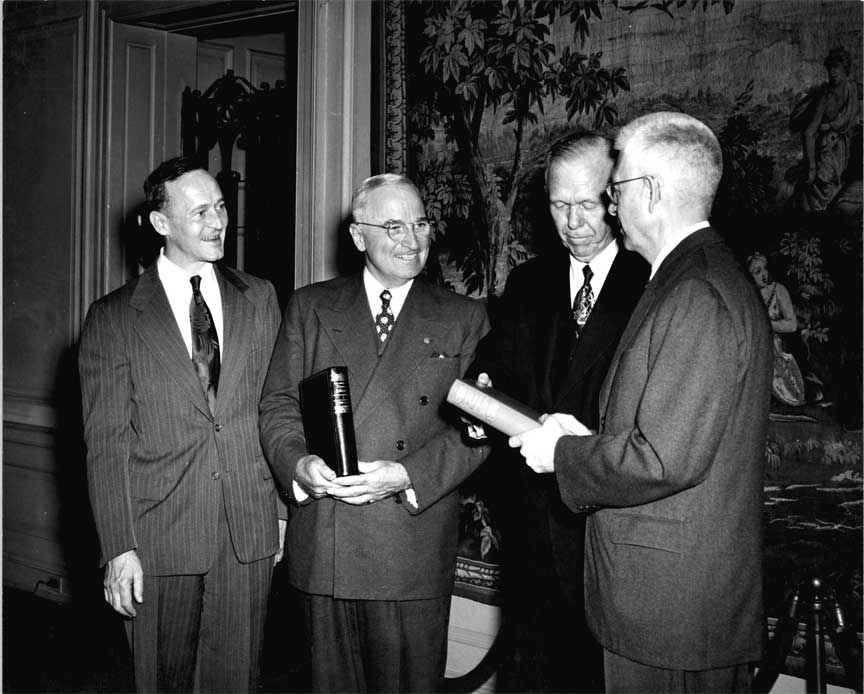1947 Marshall Plan Announced

President Truman with Secretary of State George Marshall to his right
The Marshall Plan originated from a speech by Secretary of State George Marshall at Harvard University in June 1947 calling for aid to Western Europe. Over the next four years, the United States gave over $12 billion ($100 Billion in today's money) to the countries of Europe.
The countries of Western Europe were slow in recovering from World War II. That was initially especially true of Germany where the initial plan had been to strip Germany of much of its industrial base. A concern quickly developed that the Soviets would exploit the weakness of economies in Western Europe to help communist parties come to power in many of the countries.
George Marshall was appointed Secretary of State in January. In March 1947 Former President Hoover returned from Europe and presented a report attacking the ongoing plan to deindustrialize Germany. He wrote that “There is the illusion that the New Germany left after the annexations can be reduced to a 'pastoral state'). It cannot be done unless we exterminate or move 25,000,000 people out of it.” Beyond Hoovers report, there was a growing understanding that if Europe was to recover Germany had to be part of that recovery.
The United States tried to negotiate with the Soviets to reach an agreement on the future of Germany, but after those talks seemed to be going nowhere, the US realized that it would have to go it alone. President Truman had already requested aid for Greece and Turkey who were being directly threatened by Communist expansion when he elucidated the Truman Doctrine. In
On June 5, 1947, General (Secretary of State) Marshall addressed the graduating class at Harvard. In that address, he called for economic aid for European countries. He stated:
The modern system of the division of labor upon which the exchange of products is based is in danger of breaking down. ... Aside from the demoralizing effect on the world at large and the possibilities of disturbances arising as a result of the desperation of the people concerned, the consequences to the economy of the United States should be apparent to all. It is logical that the United States should do whatever it can do to assist in the return of normal economic health to the world, without which there can be no political stability and no assured peace. Our policy is not directed against any country, but against hunger, poverty, desperation, and chaos. Any government that is willing to assist in recovery will find full co-operation on the part of the United States. Its purpose should be the revival of a working economy in the world to permit the emergence of political and social conditions in which free institutions can exist.
Immediately after the speech the British and French prepared an immediate European response to accept the offer. The Soviets, however, rejected the offer, not only for themselves but all their newly acquired satellite states of Eastern Europe. Yugoslavia which had to maintain a certain level of independence did not reject the offer and eventually received some American aid, outside the framework of the Marshall Plan.
In the meantime, Marshall instructed American representatives in Germany to cease all attempts to limit the industrial recovery of Germany.
Marshall’s speech had not included any detail and dollar figures. That was converted into the real world by the Foreign Assistance Act of 1948 which passed the Congress in March of 1948 and was signed into law by President Truman on April 3, 1948.
The act gave grants and loans for the next three fiscal years the countries of Europe as well as technical assistance. The two largest recipients were Great Britain who received a total of $3,297,000,000 and France which received $2,296,000,000. Other countries that received aid included Austria, Belgium, Denmark, West Germany, Greece, Iceland, Italy, Netherlands, Norway, Portugal, Sweden, Switzerland, and Turkey. While economist and historians argue as to what extent the aid contributed to the European recovery, one fact is clear, by the time the program ended European economic activity had returned to pre-war levels.
 >
>